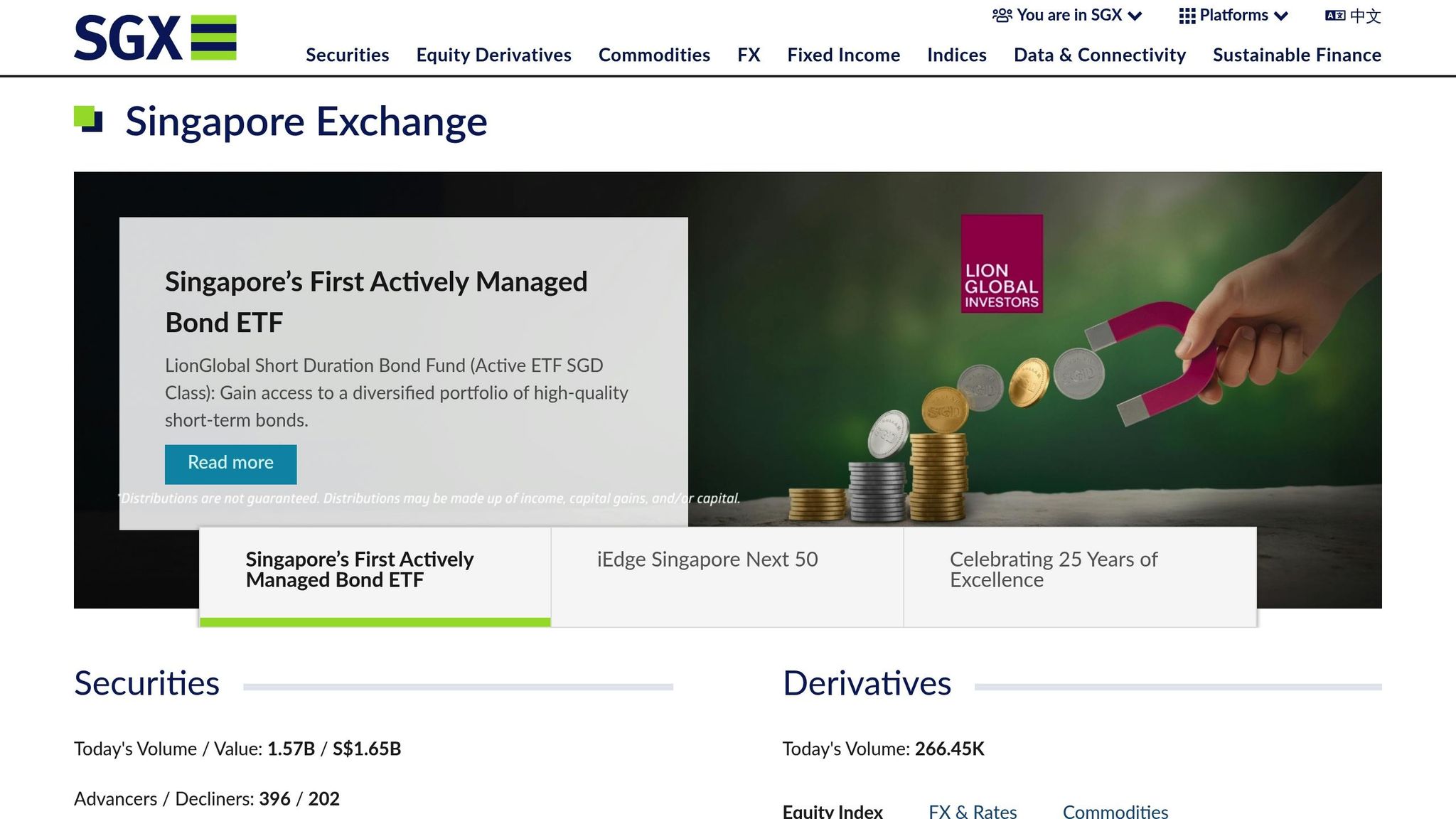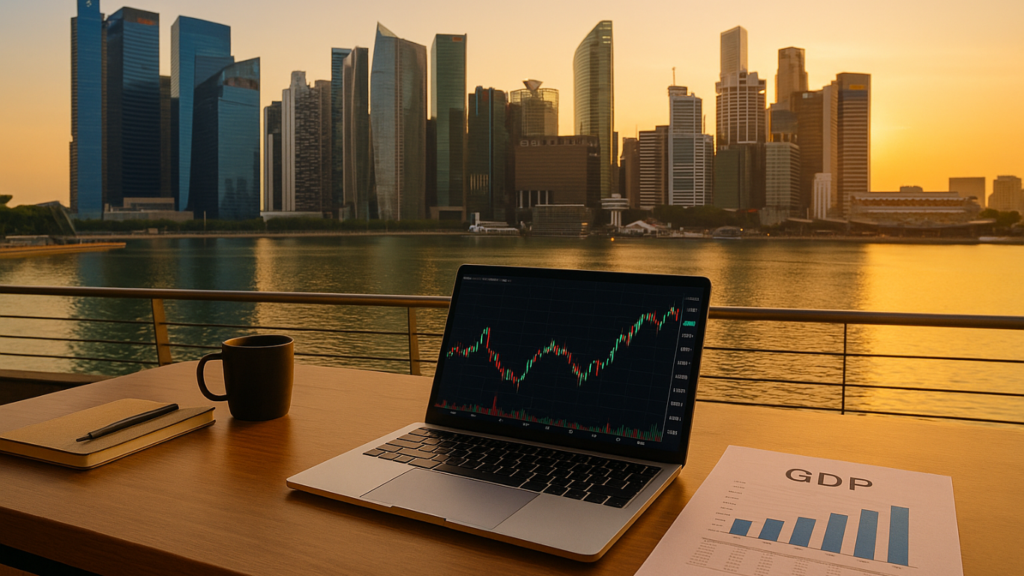Understanding GDP can sharpen your trading strategies. GDP measures a country’s economic health and is closely tied to stock market performance. For Singapore, its open economy means GDP heavily depends on global trade, government-linked corporations (GLCs), and foreign investments. Key takeaways:
- Why GDP Matters for Traders: It signals economic health, influencing market sentiment.
- Singapore’s Economic Structure: Trade accounts for 320% of GDP; GLCs and foreign investments are major drivers.
- Sector Sensitivity: Financials, real estate, and trade-related sectors respond strongly to GDP changes.
- Using GDP in Trading: Align GDP trends with technical analysis for better market timing.
Singapore’s GDP cycles can guide traders in identifying market patterns and sector shifts. For instance, GDP growth often boosts financials and real estate, while slowdowns favour defensive plays like high-dividend stocks. Start leveraging GDP data to refine your trading strategies today.
How Singapore Calculates GDP
Understanding how Singapore determines its GDP helps traders grasp the reliability of the data and the timing of economic updates that influence market movements. The Singapore Department of Statistics (DOS) employs three complementary methods to calculate GDP. Let’s break down these approaches.
Production Method
The production method, also called the output approach, is Singapore’s primary way of calculating GDP. DOS regards this as the key method for compiling national economic data. It works by summing up the gross value added (GVA) across all sectors – essentially, total output minus the value of intermediate inputs.
To gather this data, DOS taps into various sources. For manufacturing, the Economic Development Board conducts a Monthly Survey covering over 160 industries, which account for more than 85% of the sector’s value added. Construction data comes from monthly payments certified by the Building and Construction Authority (BCA), with additional estimates for renovation and maintenance. Financial services rely on the Monetary Authority of Singapore‘s Quarterly Survey, which includes banks, finance companies, and insurers. Wholesale and retail trade figures incorporate external trade data, factoring in gross markup margins on re-exports and retained imports.
Expenditure Method
The expenditure method calculates GDP by adding up all spending on final goods and services within Singapore. It follows the formula:
GDP = C + I + G + (X – M)
Here, C refers to private consumption, I to gross fixed capital formation, G to government consumption, and (X – M) to net exports.
In 2024, private consumption amounted to S$230,320.4 million, government consumption reached S$77,489.8 million, gross fixed capital formation was S$160,158.9 million, and net exports contributed S$257,327.6 million. This breakdown underscores the critical role of trade in Singapore’s open economy.
Income Method
The income method looks at GDP through the lens of total income generated. It adds up components such as employee compensation, gross operating surplus, and taxes on production minus subsidies. This approach provides additional insights into sector-specific income trends, helping traders interpret market performance more effectively.
Since the mid-1990s, DOS has utilised all three methods to calculate GDP. As DOS explains:
“In theory, these three approaches to GDP should yield the same estimate. However, as they are compiled independently from different data sources, it is inevitable for differences to arise. DOS considers the output approach to be the main approach, and regards the difference between expenditure-based and income-based GDP from output-based GDP as statistical discrepancies.”
GDP Growth Trends and Stock Market Performance
GDP growth provides valuable insights into market trends. In Singapore, the interplay between the country’s economic structure and the composition of the SGX creates patterns that traders can use to their advantage. Let’s delve into how GDP insights shape Singapore’s market dynamics.
Singapore’s GDP Growth History
Over the past two decades, Singapore’s GDP growth has followed distinct cycles, reflecting global economic events. These fluctuations offer crucial patterns for traders to observe.
| Year | GDP Growth (%) | Key Economic Events |
|---|---|---|
| 2008 | 1.9% | Global Financial Crisis |
| 2009 | 0.1% | Post-crisis recovery begins |
| 2010 | 14.5% | Strong rebound |
| 2019 | 1.1% | US-China trade tensions |
| 2020 | -4.1% | COVID-19 pandemic |
| 2021 | 7.6% | Post-pandemic recovery |
| 2022 | 3.0% | Normalisation |
| 2023 | 2.3% | Moderation |
| 2024 | 4.4% | Current growth |
For instance, the 2010 rebound, with its 14.5% GDP growth, coincided with a strong rally in the STI. On the other hand, the 2020 contraction of 4.1% during the COVID-19 pandemic resulted in significant market turbulence, followed by a robust 7.6% recovery in 2021.
Looking at the broader picture, Singapore’s GDP in local current prices has grown at an annual rate of 5.86% over the past eight years. This steady growth has translated into strong market returns, with the STI delivering about 10% per annum over five years and 11.6% per annum over three years as of March 2025.
How GDP Affects SGX Sectors

The composition of the Straits Times Index (STI) means certain sectors are particularly sensitive to GDP changes. Financials make up over 50% of the STI, with Real Estate accounting for 15.6%. This concentration amplifies the impact of GDP fluctuations on these sectors.
- Financial Services: This sector closely tracks GDP growth. When the economy expands, there’s typically more demand for loans, better credit quality, and higher trading volumes. For example, during Singapore’s 4.4% GDP growth in Q2 2025, the finance and insurance sector emerged as a key driver. Singapore’s position as a regional financial hub further magnifies the influence of both domestic and regional economic activity on its banks.
- Real Estate: This sector is deeply tied to GDP cycles. Economic growth boosts construction, property transactions, and REITs. In 2025, the construction sector is projected to grow by 4.7%, highlighting its sensitivity to GDP trends. However, during downturns like the 2020 contraction, real estate tends to underperform.
- Manufacturing and Trade-Related Sectors: With Singapore’s trade-to-GDP ratio at a massive 320%, these sectors are highly responsive to economic shifts. In Q2 2025, wholesale trade grew by 4.7%, and manufacturing expanded by 5.2%, contributing significantly to GDP. However, global trade slowdowns can pose challenges for these industries.
- Technology Stocks: Although they account for only 1.0% of the STI, tech stocks provide diversification during different phases of the GDP cycle. This unique composition causes the STI to behave differently from other APAC markets during periods of tech-driven growth.
These sector-specific dynamics highlight the importance of understanding GDP trends when making investment decisions.
Using GDP Cycles for Market Timing
By understanding how sectors respond to GDP changes, traders can use tools like the Composite Leading Index (CLI) to anticipate market movements. The CLI has consistently provided early signals, averaging a five-month lead over economic cycles from 2010 to 2024.
For example, during the growth cycle recession that began in September 2022, the CLI peaked nine months before the Composite Coincident Index and bottomed out two months ahead of the recovery. This predictive capability allows traders to time their market entries more effectively.
Interestingly, stock market indices are components of the CLI, creating a feedback loop that traders can exploit. When the CLI diverges from current market pricing, it often signals upcoming GDP-driven market shifts.
Historical data also shows that market valuation relative to GDP is a reliable predictor of long-term returns. Outward-oriented sectors like manufacturing and wholesale trade tend to perform well when GDP growth exceeds the long-term average of around 3–4%. Conversely, during slower growth periods, defensive sectors and high-dividend stocks become more appealing.
In today’s environment, with GDP growth expected to moderate in the second half of 2025, traders might consider shifting their focus. Reducing exposure to trade-sensitive sectors and increasing investments in domestic-oriented businesses or high-dividend financial stocks – offering yields of 4.9% – could be a prudent strategy.
The Ministry of Trade and Industry summarised the current economic sentiment:
Singapore’s economic outlook for the rest of the year remains clouded by uncertainty, with the risks tilted to the downside.
This uncertainty presents challenges, but it also opens up opportunities for traders who can interpret GDP cycles and align their strategies with sector-specific trends.
Master Systematic Trading with Collin Seow
Learn proven trading strategies, improve your market timing, and achieve financial success with our expert-led courses and resources.
Adding GDP Analysis to Your Trading System
Using GDP data can sharpen your market timing and sector allocation strategies. Instead of viewing GDP as mere background information, traders are leveraging it to refine their systematic approaches in Singapore’s markets.
Using GDP Data in Trading Models
GDP analysis can be integrated into trading models using tools like multiple regression to blend market data with economic indicators. As Collin Seow Trading Academy highlights:
multiple regression can combine market data with economic indicators like GDP growth or interest rates, offering a broader perspective.
This approach is particularly effective for Singapore traders, given the close relationship between GDP cycles and market performance. To build a robust trading model, include GDP data alongside your usual market metrics for SGX-listed equities, REITs, and ETFs. However, treat GDP as one part of a multi-factor model rather than relying on it alone.
Use Singapore’s quarterly GDP releases to shape your market bias, aligning these insights with short-term technical signals for precise entry and exit points. For example, if GDP growth is accelerating but weekly charts show bearish divergences in specific stocks, that mismatch warrants deeper analysis before making investment decisions.
Regression analysis can also help quantify connections between GDP components – like manufacturing output or services growth – and specific market sectors. These insights allow you to create sector rotation models that anticipate market moves before they become widely recognised.
These techniques lay the groundwork for applying GDP analysis in real-world trading scenarios.
Practical Tips for Singapore Traders
Singapore’s economic landscape provides unique opportunities for traders using GDP-based strategies. The quarterly GDP data from the Ministry of Trade and Industry serves as a valuable guide for adjusting your approach.
To identify early market shifts, track leading indicators alongside GDP data. Divergences between these indicators and current market trends often signal changes that GDP figures will later confirm.
Sector-specific strategies can be especially impactful in Singapore. Key sectors like financial services and real estate often respond strongly to GDP trends. During periods of GDP growth, you might take a more aggressive approach in these areas, while a slowdown might prompt a shift towards defensive or high-dividend strategies.
When backtesting GDP-based signals, focus on using the GDP figures as they were originally reported to avoid look-ahead bias. Pay attention to the direction of GDP changes rather than their absolute values. After each quarterly release, review your positions, monitor sensitive sectors for early signals, and adjust position sizes or stop-loss levels to account for data uncertainty.
Expert guidance can help you master these strategies.
How Collin Seow Trading Academy Can Help

Collin Seow Trading Academy offers structured frameworks to help traders incorporate fundamental data like GDP into systematic trading strategies. Their focus on disciplined processes helps traders minimise emotional decisions when interpreting economic data.
The academy’s systematic trading methodology blends technical analysis with fundamental insights for a well-rounded approach. As they explain:
At Collin Seow Trading Academy, systematic trading strategies often integrate regression analysis with other technical methods. This combination not only strengthens the accuracy of insights but also reduces the risks of relying on a single indicator.
Through resources like free e-courses, including Market Timing 101, the academy bridges the gap between theoretical concepts and practical trading applications. Their structured approach helps traders avoid common mistakes. As the academy notes:
Structured trading strategies help you avoid emotional pitfalls. By relying on methods such as moving averages, regression analysis, or technical indicators, you can filter out market noise and focus on meaningful patterns.
For those seeking more advanced instruction, the academy offers programmes that delve deeper into combining various analytical methods. These resources enable traders to select the right tools for different market conditions. If you’re ready to incorporate GDP analysis into your trading systematically, Collin Seow Trading Academy provides the guidance needed to turn theoretical knowledge into actionable strategies.
They also stress the importance of tracking outcomes. Keeping detailed records of your predictions and their results helps refine your methods and builds confidence in your analysis over multiple economic cycles.
GDP Analysis Limitations and Best Practices
While GDP analysis gives a helpful snapshot of economic health, its true value emerges when paired with other macroeconomic and financial indicators.
Combining GDP with Other Indicators
GDP analysis becomes far more insightful when combined with additional data points. For instance, blending GDP figures with other indicators can significantly improve predictions for future GDP growth and stock market trends. A good example is the Consumer Confidence Index (CCI), which has shown remarkable accuracy in forecasting consumer spending – something that makes up about two-thirds of the U.S. GDP. In Singapore, keeping an eye on consumer sentiment alongside GDP can provide a clearer picture of how the retail and services sectors are performing.
Another useful metric is the Purchasing Managers Index (PMI), which has a strong track record of predicting GDP growth. To refine market forecasts, it’s beneficial to integrate GDP data with a mix of indicators: leading ones like employment data, coincident ones like industrial production, and lagging ones like corporate profits.
On top of that, machine learning has opened up new possibilities by uncovering complex relationships between GDP and other variables, leading to even better prediction accuracy.
Best Practices for Systematic Traders
For systematic traders, incorporating GDP into your strategy requires careful planning. GDP trends can serve as a foundation for setting market bias – bullish during economic expansion and cautious during slowdowns. However, it’s crucial to complement this with technical signals for timing your entries and exits.
Tracking how GDP interacts with other indicators across multiple economic cycles can reveal consistent patterns, helping you make more informed predictions. Equally important is a robust risk management plan, which includes setting clear position sizes and stop-loss levels to protect against unexpected market shifts.
Advanced forecasting techniques, such as Ensembled Direct Multi-Step (EDMS) models, can further improve accuracy by combining insights from multiple models that adapt to changing data conditions.
Lastly, maintaining detailed records of your GDP-based forecasts and their outcomes is essential. This practice not only helps fine-tune your strategy but also builds confidence in your systematic approach over time. By combining these methods with GDP insights, you create a well-rounded framework for effective market analysis.
Key Takeaways for Traders
Why GDP Matters for Market Analysis
GDP is a key piece of the puzzle for Singapore traders, offering a window into the overall health and direction of the economy. It helps you spot patterns in market behaviour, anticipate sector shifts, and align your portfolio with the current economic phase – whether Singapore is experiencing growth, a peak, a slowdown, or a contraction. For example, when GDP data highlights robust growth in manufacturing, SGX-listed industrial stocks often see a boost, as investor confidence in those sectors rises. By aligning your trading strategy with these economic trends, you can avoid going against the broader market forces that might undermine even the most well-planned technical trades.
It’s worth noting that advanced GDP estimates are preliminary and shouldn’t be the sole basis for major trading decisions. Singapore’s unique economic setup also means that traditional Gross National Income (GNI) figures can be misleading, as a significant portion of income flows to foreign entities rather than local residents. For a clearer understanding of Singapore’s domestic economic conditions, Indigenous GNI is a more reliable metric. These considerations are essential for traders looking to weave GDP analysis into their strategies effectively.
Next Steps for Singapore Traders
Start integrating quarterly GDP data into your trading process. Pay close attention to how various sectors react to economic announcements and the revisions to GDP figures, which can continue for up to two years after the initial release. To make this integration seamless, create a simple checklist that combines GDP trends, sector-specific impacts, and your usual technical indicators. This can help you make more informed decisions when navigating Singapore’s unique market environment.
For those who want to strengthen their trading skills, the Collin Seow Trading Academy offers courses designed to teach you how to incorporate macroeconomic data, like GDP, into your trading strategies. Their systematic approach enables you to build a structured framework that blends economic analysis with technical tools, giving you a more comprehensive view for making trading decisions.
Begin cautiously. Experiment with GDP analysis by paper trading or using smaller position sizes while you refine your approach. Keep detailed records to compare how trades influenced by GDP data perform against those based purely on technical analysis. Over time, this will help you fine-tune your strategy and gain confidence in using GDP as part of your trading toolkit.
FAQs
How can traders in Singapore use GDP data to predict stock market trends and sector performance?
In Singapore, traders can use GDP data to spot trends in the stock market by honing in on sector-specific growth. Sectors like manufacturing, finance, and trade often play a major role in shaping market performance. For instance, if GDP growth is driven by these industries, it could indicate promising opportunities for investments focused on those areas.
Singapore’s exceptionally high trade-to-GDP ratio – over 300% – further underscores the importance of export-driven industries. When GDP expands, export-related sectors often see strong growth, giving traders a chance to align their strategies with the broader economic momentum. By diving into quarterly GDP reports and analysing which sectors are driving growth, traders can stay ahead of market trends and make well-informed decisions.
What are the drawbacks of using only GDP data for trading decisions, and how can traders address them?
GDP is often seen as a core measure of economic performance, but it has its blind spots. For one, it doesn’t account for how income is distributed across a population, leaving out crucial details about economic inequality. It also overlooks environmental impacts and the shadow economy – those informal or unreported economic activities that can be significant in some regions. Because of these gaps, GDP alone can give an incomplete picture of a nation’s economic health.
Another issue is timing. GDP figures are released quarterly, meaning they don’t always capture real-time economic trends or short-term market shifts. For traders, this lag can make GDP less useful for spotting immediate opportunities or risks.
To get a clearer, more actionable view of the economy, it’s better to combine GDP data with other indicators. Employment rates, consumer confidence indices, and industry-specific metrics can fill in the blanks that GDP leaves behind. By taking this broader approach, traders can base their decisions on a more nuanced understanding of the market.
How do the production and expenditure methods of calculating GDP provide insights into Singapore’s economic health?
The two primary ways to calculate Singapore’s GDP – the expenditure method and the production method – each provide a distinct perspective on the country’s economic landscape.
The expenditure method emphasises total spending on goods and services, making it particularly relevant for Singapore. With its trade-to-GDP ratio exceeding 300%, trade and consumer activity are central to the nation’s economy. This method highlights how trade flows and consumer spending patterns impact overall economic performance.
In contrast, the production method focuses on the value added by various industries. It offers insights into how key sectors like manufacturing and services contribute to Singapore’s economic foundation. These industries form the backbone of the economy, driving growth and providing stability.
By using both methods together, policymakers and analysts can achieve a more comprehensive view of Singapore’s economic health. The expenditure method reveals trends in trade and consumption, while the production method highlights the critical role of industrial performance in sustaining the nation’s progress.












